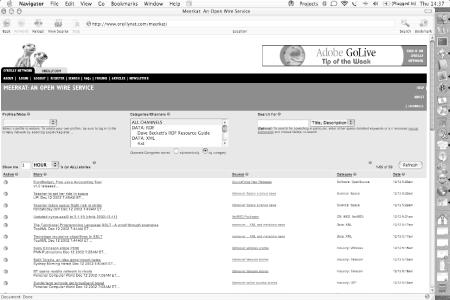Web Aggregators: Introducing Meerkat
Meerkat
was the first truly open-to-all, searchable, categorized aggregator.
Developed by Rael Dornfest, Chair of the RSS 1.0 Working
Group and researcher for O’Reilly (the publisher of
this book), Meerkat (http://www.oreillynet.com/meerkat/) takes the
RSS feeds from a whole range of sites, throws all of the
items into a big pot, and makes the resulting mix
searchable. Aggregating feeds in this way allows for custom feeds to
be made—“The latest news on Java,” say, or “Everything
containing the keyword `sausages’
written in the past 30 minutes.”
Meerkat is primarily usable via its web interface, shown in Figure 10-2. This introduces two main concepts for the application: profiles and mobs. To use either of these features, you must first sign up for a user ID with the O’Reilly Network (http://www.oreillynet.com).

Figure 10-2. A screenshot of Meerkat’s front page
Profiles are named sets of query parameters. There are global parameters already loaded into Meerkat, based on subject matter (Apache, Perl, P2P, etc.), and you can save your own from the web interface.
Mobs, on the other hand, are collections of stories. You use a mob like a universally retrievable bookmark list. You can add stories to it via the web interface, send its URL to other people, or even query and display the mob via the Meerkat API.
The what? Well, let me tell you . . .
The Meerkat ...
Get Content Syndication with RSS now with the O’Reilly learning platform.
O’Reilly members experience books, live events, courses curated by job role, and more from O’Reilly and nearly 200 top publishers.

